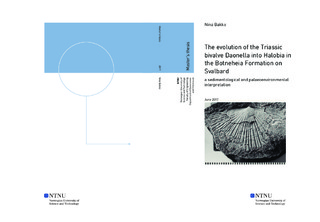| dc.description.abstract | The Svalbard Triassic succession represents an uplifted section of a broad epicontinental shelf at the north-eastern margin of Pangea. The Botneheia Fm. of the Middle Triassic is an organic carbon-rich bituminous shale, which records a second order transgressive−regressive cycle. The deterioration of oxygen levels in the bottom waters of the open shelf environment and widespread preservation of organic material, makes the Botneheia Fm. an important source rock in the region, containing up to 12 % organic carbon.
The anoxic/oxic bottom environment switching events that occurred during the deposition of the uppermost part of the Botneheia Fm., the Blanknuten Mb., are reflected in the marine fauna; abrupt mass mortality events are represented by marine reptilian bone fragments hosted in coquina shell beds, dominated by the bivalve Daonella. These events are closely followed by periods of oxygenated waters, a flourishing Thalassinoides tracefossil assemblage interbedded with thin fossil-free laminations.
Detailed field observations and measurements of the Botneheia Fm. were collected by the author in 2015 and 2016 as a part of the Svalbard Triassic Research Group, a cooperation between NTNU and UNIS. A total of 18 sections in central and eastern Svalbard were logged and sampled for fossil content. Numerous samples of different species of the bivalve Daonella where taken throughout each section, as well as other fossils, including ammonoids.
Daonella were remarkably widely distributed across the Tethys, Panthalassa and Boreal regions and therefore serve as an excellent index fossils. The evolution of Daonella into Halobia, marking the Ladinian-Carnian boundary is well documented however the systematics are incoherent. In addition to this, the mode of life for the Daonella is still disputed. They have been interpreted as pseudoplanktonic, nektonic and epibenthic chemosymbionts, amongst several other theories. Fossil material from the 2015/2016 field season has helped to refine the halobiid biostratigraphical scheme on Svalbard and suggests a reclining epibenthic mode of life on soft, soupy sediments, in oxic to dysoxic milieus.
Samples of Daonella collected for this study are compared to images of holotypes and identified specimens from various museum collections. Species identification and age estimates have contributed to a better understanding of facies dependence and shed light on the causes for change in paleoenvironment within the Botneheia Fm. Unidirectional orientation in Daonella indicates the presence of currents on the sea floor which is in support of the theory of a Triassic upwelling zone along the north-eastern shelf edge of Pangea during the Middle Triassic. | |

